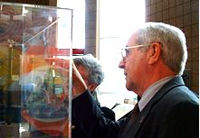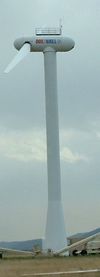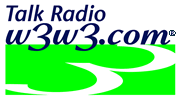|
NWTC
|| Riding on the Wind || NREL/SERF || Bob
Thersher ||
Admiral Truly || NREL - 25 Years In A Day.... |
Photo
Links
You may be surprised to learn, as we were, that Wind is one of the biggest success stories in the Renewable Energy collection!
About 10 years ago Larry Flowers formed another group. They named themselves Village Power. It is a needs-driven enterprise. Village Power travels the world to help rural populations by installing wind and solar power stations to clean their water, improve health, access to education and enhance their enterprise to have a better life so they don't think they must move to the city to make money to send home. This trend has become a tremendous burden for the cities Village Power has now grown to 700 people. This August, Village Power and renewable energy sources will be a topic on the World Bank Conference agenda in Johannesburg, South Africa to raise interest in development funds on a worldwide basis. The efforts of Village Power and Wind-Powering America help secure the well-being and safety of people all around the world now and in the future. Carpe Ventem! The future of Wind Power is brilliant with the the lights of such people as Admiral Truly with his leadership and vision, to the engineers such as Scott and Andy who specifically craft their knowledge and material into clean, soon to be abundant energy. The National Renewable Energy Laboratory celebrated its' 25th Anniversary, on July 5th, the day after our nation's Independence Day. The symbolic significance between the two dates must inspire the spirit of NREL's enthusiastic staff and their quest for energy independence. To celebrate, NREL employees expressed their wish to build an energy efficient house with Habitat. NREL's Managing Partners MRI, Battelle and Bechtel agreed to sponsor their wish by paying a $60,000.00 materials fee. NREL employees and their families will provide the 3,000 or so hours of labor to get the job done. |
|||||||
|
RENEWABLE
ENERGY:
THE ANSWER IS RIDING ON THE WIND... around Hwy 128 at National Wind Technology Center in Boulder, CO by: Kate Hamers Since 1977, the National Renewable Energy Laboratory's highly lauded research program has yielded numerous patents and licensing opportunities (i.e. wind and solar power, plant derived fuels and chemicals, energy efficient buildings, advanced vehicle design, and hydrogen technologies). NREL benefits local, state and national communities. The NREL Web site contains vital information on how to get involved at any level, from HOT licensing opportunities to home energy improvement seminars. Just go to http://www.nrel.gov. NREL's Technology Transfer Team is dedicated to transforming their expertise into commercially available products in local industry and throughout the country. The Technology Transfer Team provides expertise in business marketing, engineering, program management and R&D to those interested through the Incubator Alliance Program. Over half of NREL's annual budget goes back to the communities with which it works. National Wind Technology Center Today we're touring the National Wind Technology Center, the world's largest most sophisticated test center for wind. Our host is Robert Noun, Director of Communications & Public Affairs for NREL He says, "The wind turbine's basic design is the same design the world has used for thousands of years. We have combined the windmill with the turbine to produce electricity. The design is simple and elegant. The functional elements used are aero, structural and electrical. "Since 1977, when we first began to generate electricity with wind, we have cut the cost from 80 cents to 4 and 5 cents per kilo watt hour. We have a great success story here. We can deliver electricity to remote villages who have never experienced electricity or to rural farms that cannot afford the unthinkable costs associated with connecting to a faraway grid. "We have a ways to go to expand the number of sites around the country. But in 1985 only California and Vermont had significant, installed wind power. Today in 2002 we have 5,000 mega watts of installed power, 1000's of machines in a dozen states. One mega watt hour serves about 300 homes." Bob arranges for another driver and himself to take our group out to the fields where the giant turbines are perched atop their 80 ft., ultimately 120 ft. towers. Here we meet up with Alan Laxson, Business Outreach, and pile into his vehicle, turbine bound. Oh yes! Some of us will tour to the top. When we arrive, people come out of nowhere and help us into an elevator at the base of the tower and at the end of which is a daunting climb to the top. We are also met by Andy Meisser and Scott Wilde (say Wildly without the 2nd L) to help us understand what we are seeing. There is nothing impersonal about their work here. Andy and Scott brought these Westinghouse wind turbines and towers all the way from a 1980's Hawaii wind farm for testing here at the National Wind Technology Center. "This site is really hard on the equipment," Andy laments. Sometimes the winds come at speeds high above 100mph. Hawaii was an ideal place for wind farming as gentle trade winds blow across the Pacific at a steady 13 miles per hour. Andy and Scott pepper us with statistics about turbines, blades and structural dynamics. Dynomometers are used to test the drive trains; future dynomometers are being designed to test 5 and 10 mega watt wind turbine machines; The configuration for utility wind parks in California is between 1,500 and 2,000 mega watts which can supply a city the size of San Francisco. Peak Producing Winds The operational speed of the turbines at the test center is between 9 and 44 mph but the peak producing speeds are between 28 and 38 mph. The turbines lock down at speeds beyond 44 mph to protect the windmill from mechanical damage. To produce good quality electricity the wind must move at a steady rate. The wind season in Colorado is November through May. The Equipment Design Wind Turbines are modular. This design feature makes easier the tasks of maintenance, repair and shipping to remote sites. They come in a few sizes and shapes and usually have 2 or 3 blades. Turbines are getting bigger and producing more power but we are learning the limits. When the towers get too high problems develop such as bending blades and bearing failures. Studies have begun on producing power from the lower level jet stream as well as producing power from low speed winds. General Electric bought ENRON's wind turbines a while back." (Thrilling news. G.E. is known for its community spirit and good business sense.) Challenges for Wind Power Storage is the weak link of the wind power story. "We are working hard to develop storage options to extend the usage of power, says Bob. Power cannot be sent on demand in large quantity. In this scenario wind power is looked upon more as a way to economize on more expensive fuels. Distribution is problematic. The national grid needs to expand and upgrade for the future. Larry Flowers and the WHO? Larry Flowers is a politically savvy, international figure in the dissemination of wind power technology. His humor and passion fire more than his own determination. He considers Bob Noun a national hero for saving the wind program from certain death in the 1980's. "Bob kept the program alive in congress 'til the more favorable times of the '90's." Larry's motto and theme is a tongue in cheek, yet serious battle cry he coined for his work, "Carpe Ventem!" - Seize the wind! This bigger than life dynamo channels his energy into two major projects. One is Wind-Powering America and the other Village Power International. Wind Powering America's focus is spreading wind power technology into areas that are stuck, and to those who should work with wind technology, such as city, state and federal organizations. Three Critical Issues: National Renewable Portfolio Standards Mandates would require a certain percentage of power to be produced in each state by wind technology. The mandate should drive wind power development from a market standpoint (i.e.. lowest cost supplies).Transmission Rules Energy Transmission Policy is based on who is at the table when the rules are being made. Incentives to get other players into the game such as Native Americans, farm and ranch co-ops, county commissioners and legislators. |
||||||||
|
BACK To: NWTC || Riding on the Wind || NREL/SERF || Bob Thersher || w3w3
media network - p o box 17340, boulder, co 80308-0340 - Voice: 303.442.1579 Copyright © 1998-2004 w3w3® Media Network |
||||||||



 Would
you like to go to the top?
Would
you like to go to the top? 